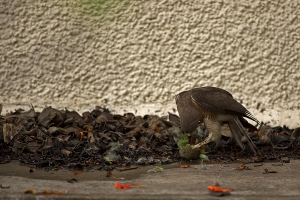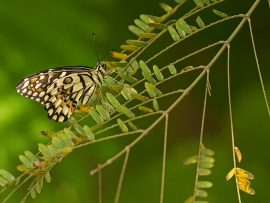In a fast-growing city like Bengaluru, real estate is an issue, not only for people but also for birds. We stay just a hop away from Vidhana Soudha, in the commercial hub and right in the middle of the central business district. The road is so congested that business establishments are taking a hit because of lack of parking space! If you can imagine that, you can also imagine the noise and pollution levels caused by traffic. But you may not be able to imagine that bird families continue to choose to make their home here, on this road. Three of them had their address on an African Tulip tree.
A Jungle Crow family had its nest of twigs on top of the tree. A White-cheeked Barbet couple found a hole further down, below the leaves. A Common Myna family selected a hole on the side opposite to that of the barbets. Barbets make neat, evenly circular holes in trees. In fact, these are near perfect, allowing no extra space when a barbet peeps out of the entrance 🙂 We didn’t see this pair excavating a new one. This must’ve been a nest they had made before and had ‘renovated’. White-cheeked Barbets are known to harass other species of barbets, taking over their nest sometimes.
It was interesting that the barbets and the mynas were staying there, despite the fact that the Jungle Crow was a potential enemy. There was also a female Asian Koel who visited this tree often – she must’ve used the Jungle Crow’s nest to lay her eggs. (Such behaviour is called brood parasitism. You can view an animated description of the same in the Indian movie, 3 idiots).

Days went by and the young ones of the Jungle Crow were now visible in the nest. Whenever they were awake, they always seemed to have their mouths open. Doesn’t it ache, we wondered! One of the parents would come with some food every now and then, regurgitate and feed them.
We did not see the myna chicks as we were travelling during that time 😦 However, the White-cheeked Barbet couple used to sit on the nearby gulmohar and tamarind trees. They would call almost all day, going ‘Guturu, guturu’. Did you know these barbets call without opening their beaks? We never saw the young ones and the sound of the barbets gradually reduced over the months.
Meanwhile, the Jungle Crows grew up healthily. There were a couple of torrential rains and heavy wind, but the family and its nest survived all of that.

Gulmohar tree in full bloom
A couple of months went by. By now, the gulmohar (Kattikai mara) was in full bloom.

It was one of these days when we were in the middle of some ‘serious discussion’ at around 11 AM. We heard a shrill scream. All discussion abandoned, we ran to the balcony and saw a rather small raptor fly onto a ledge on the adjacent building. It was a Shikra!
It is not rare to see one in places where people stay, but amidst all that traffic, all that noise, here was a Shikra, ready to enjoy a nice midday meal. And just what was its meal ? One of our young neighbours, a tiny little barbet chick. We hadn’t seen the young ones before – and we got to see one of them now, as a meal. The barbet continued screaming for some time, while the Shikra pecked and plucked at it. Despite knowing it had audience, it went about eating. After some time, it decided to have a change in venue, picked up its meal and flew onto the Gulmohar tree.

Two days went by and the air was filled with the same shrill screams. It was a young barbet, again ! But this time, two Jungle Crows had caught hold of it. They didn’t want to have audience and flew away to a different tree, to enjoy their meal in peace and privacy.
The Shikra was one of the birds used for hawking or falconry (natives used to train birds of prey for their sport of hunting). It is rather slow compared to others birds used in a falconry. Apparently, a tame Shikra cannot even attempt to catch a bird, unless someone ‘throws’ the Shikra at a prey it is supposed to catch! However, falconers (hunters) usually have shikras with them, because shikras are very brave, can catch big birds now and then and can be trained easily.
 A Shikra’s normal diet contains lizards, mice, insects and small birds. Of late, there are bats visiting our African Tulip tree. I have read of instances where Shikras have fed on bats. Will it come to feed on the bats, I wonder.
A Shikra’s normal diet contains lizards, mice, insects and small birds. Of late, there are bats visiting our African Tulip tree. I have read of instances where Shikras have fed on bats. Will it come to feed on the bats, I wonder.
Rana
References:
- Notes on the falconidae used in India in falconry
- Wiki notes on Shikra
- Stray bird notes from Rishi Valley
- Muni, M. and Hegde, V., 1998. Indian Shikra preying on Short-nosed Fruit Bats. Bombay Natural History Society, 95(2): 338-339.
- Zarri, A. A., 2001. More information on shikra Accipter badius (Gmelin) feeding on shortnosed fruit bats Cynopterus sphinx Vahl. Bombay Natural History Society, 98(1): 106-107.
- Agoramoorthy, G., 2001. Predatory attack on bats by barn owl Tyto alba and shikra Accipiter badius in Tamil Nadu state, south India Bombay Natural History Society, 98(1): 107-108.
- Yahya, H. S. A., 1989. Breeding biology of barbets, Megalaima spp. (Capitonidae- Piciformes) at Periyar Tiger Reserve, Kerala. Bombay Natural History Society, 85(3): 493-511.











